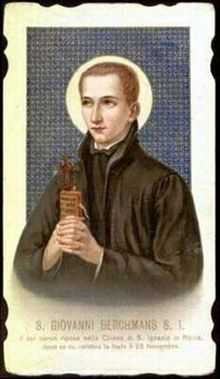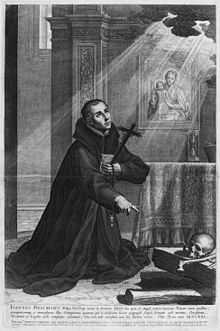John Berchmans
| Saint John Berchmans, SJ | |
|---|---|
 | |
| Jesuit Scholastic and Saint | |
| Born |
13 March 1599 Diest, Belgium |
| Died |
13 August 1621 (aged 22) Rome, Italy |
| Venerated in | Catholic Church |
| Beatified | 1865 |
| Canonized | 15 January 1888 |
| Major shrine | Sant'Ignazio |
| Feast |
26 November (after 1969) 13 August (until 1969) |
| Attributes | Often depicted with hands clasped, holding his crucifix, his book of rules, and his rosary. |
| Patronage | Altar Servers, Jesuit scholastics, and students |
Saint John Berchmans (Dutch: Jan Berchmans) (13 March 1599 – 13 August 1621) was a Jesuit scholastic and is a saint in the Roman Catholic Church. He is the patron saint of altar servers.
Early life
John Berchmans was born 13 March 1599, in the city of Diest situated in what is now the Belgian province of Flemish Brabant. The son of a shoemaker, his parents were John Charles and Elizabeth Berchmans. He was the oldest of five children and at baptism, was named John in honor of St. John the Baptist. He grew up in an atmosphere of political turmoil caused by a religious war between the Catholic and Protestant sections of the Netherlands.[1] When he was age nine, his mother was stricken with a long and serious illness. John would pass several hours each day by her bedside.[2] He studied at the Gymnasium at Diest and worked as a servant in the household of Canon John Froymont at Malines in order to continue his studies.[1] John also made pilgrimages to the sanctuary of Scherpenheuvel, a few miles from Diest.
Call to the Society of Jesus
In 1615, the Jesuits opened a college at Malines (Mechelen) and John Berchmans was one of the first to enroll. Immediately, when he entered, he enrolled in the Sodality of the Blessed Virgin. When John wrote his parents that he wished to join the Society of Jesus, his father hurried to Mechelen to dissuade him and sent him to the Franciscan convent in Mechelen. At the convent, a friar who was related to John, also attempted to change his mind. Finally as a last resort, John's father told him that he would cease all financial support if he continued with his plan.[3]
Nevertheless, on 24 September 1616, John Berchmans entered the Jesuit novitiate. He was affable, kind, and endowed with an outgoing personality that endeared him to everyone. He requested after ordination to become a chaplain in the army, hoping to be martyred on the battlefield.[1]
On 25 September 1618, he made his first vows and went to Antwerp to begin the study of philosophy. After only a few weeks, he set out for Rome, where he was to continue the same study. After journeying three hundred leagues by foot, with his belongings on his back, he arrived at the Roman College to begin two-years of study. He entered his third year class in philosophy in the year 1621.[2]
Later, in August 1621, the prefect of studies selected John Berchmans to participate in a discussion of philosophy at the Greek College, which at the time was administered by the Dominicans. John opened the discussion with great clarity and profoundness, but after returning to his own quarters, was seized with the Roman fever.[2] His lungs became inflamed and his strength diminished rapidly.[3] He succumbed to dysentery and fever on 13 August 1621, at age twenty-two years and five months.[4] When he died, a large crowd gathered for several days to view his remains before burial in Sant'Ignazio Church, and to invoke his intercession. That same year, Phillip-Charles, Duke of Aarschot, sent a petition to Pope Gregory XV to gather information with the intent of beatification of John Berchmans.
Spirituality
St. Aloysius of Gonzaga was his spiritual model and he was influenced as well by the example of the Jesuit English martyrs. It was his realistic appreciation for the value of ordinary things, a characteristic of the Flemish mystical tradition, that constituted his holiness. He had a special devotion to the Mother of God; and to him is owed the Little Rosary of the Immaculate Conception.[3]
Veneration

At the time of John's death, his heart was returned to his beloved province in Belgium where it is kept in a silver reliquary on a side altar in the church at Leuven (Dutch), (French: Louvain).[5] John Berchmans was declared Blessed in 1865, and canonized in 1888.[2] Statues frequently depict him with hands clasped, holding his crucifix, his book of rules, and his rosary.
The miracle that led to his canonization occurred at the Academy of the Sacred Heart in Grand Coteau, Louisiana. In 1866, just one year after the Civil War, he appeared to novice Mary Wilson. Wilson's health was poor, and her parents thought that the gentler climate of south Louisiana could be a remedy, however her health continued to decline. She could only take in liquids for about 40 days. "Being unable to speak, I said in my heart: "Lord, Thou Who seest how I suffer, if it be for your honor and glory and the salvation of my soul, I ask through the intercession of Blessed Berchmans a little relief and health. Otherwise give me patience to the end." She went on to describe how John Berchmans then appeared to her, and she was immediately healed.[6] When the Academy opened a boys school in 2006, the trustees named it St. John Berchmans School. It is the only shrine at the exact location of a confirmed miracle in the United States.[7]
His feast day was set at 13 August until the reform of the General Roman Calendar in 1969, when it was changed to 26 November.
Recognition
The Belgium Post Authority issued a philatelic stamp in 1965 featuring John Berchmans pictured alongside his parental home in Diest.[4]
The St. John Berchmans Sanctuary Society is an organization for altar servers that continues to have chapters at many parishes.[3][8]
San Antonio, Texas became home to several Belgian farmers who arrived in the late 1800s and established truck farms on the southwest edge of the city and brought their crops to the city markets for sale. Other Belgians followed in the 1890s and also established farms in the area. The community founded a school in a one-room structure that also served as a chapel when the priest from Sacred Heart Parish visited. The chapel became known as St. John Berchmans and was the Belgian national parish until 1947, with all services conducted in Flemish. The parish moved in 1948, and the former structure became home to the Belgian-American Club of Texas.[9]
In 1902, Bishop Anthony Durier requested the Jesuits establish a second parish of in Shreveport. They named the parish in honor of the saint because of the miracle in the case of Mary Wilson in nearby Grand Coteau, Louisiana. On 16 June 1986, Pope John Paul II established the Diocese of Shreveport and St. John Berchmans became the Cathedral Church.[10]
The following is partial list of schools and churches named in honor of the saint:
- Saint John Berchmans College (Brussels, Belgium)
- St. John Berchmans College (Diest, Belgium)
- St. John Berchmans College (Westmalle, Belgium)
- St. John Berchmans College (Genk, Belgium)
- St. John Berchmans College (Avelgem, Belgium)
- St. John Berchmans College (Mol, Belgium)
- St John's Beaumont (Old Windsor, Berkshire, England)
- St. John's High School (Purulia Road, Ranchi, Jharkhand, India)
- St. John Berchmans High School (Tinpahar, Jharkhand, India)
- St. John Berchmans High School (Cordon, Isabela, Philippines)
- St. John Berchmans cathedral (Shreveport, Louisiana, USA)
- St. John's Jesuit High School and Academy (Toledo, Ohio)
- St. John Berchmans School (Colegio San Juan Berchmans) (Cali, Colombia)
- St. John's College (Belize City, Belize)
- St. Berchmans College (Changanacherry, Kottayam)
- St. Berchmans Higher Secondary School, (Changanacherry, Kottayam)
- St. John Berchmans Church, attached to the Collège St Michel (Brussels, Belgium)
- St. John Berchmans Parish and School (Logan Square, Chicago, Illinois)
- St. John Berchmans Church (Holland, Manitoba, Canada)
- Église Saint-Jean-Berchmans (Montreal, Quebec, Canada)
- Berchmans Illam, Jesuit Scholastigate (Chennai, Tamil Nadu, India)
- Sint Joan Berchmans mavo (Roosendaal, the Netherlands)
References
- ↑ 1.0 1.1 1.2 Stevens, Rev. Clifford. St. John Berchmans. The One Year Book of Saints (Eternal Word Television Network). Retrieved 2013-11-20.
- ↑ 2.0 2.1 2.2 2.3 Demain, Henry (1910). Knight, Kevin, ed. "St. John Berchmans". Catholic Encyclopedia 8. New York City: Robert Appleton Company. Retrieved 2013-11-20.
- ↑ 3.0 3.1 3.2 3.3 Manual of the St. John Berchman's Sanctuary Society. New York City: Apostleship of Prayer. 1892. pp. 139–140. Retrieved 2013-11-20.
- ↑ 4.0 4.1 Fennessey, SJ, Peter. "Saint John Berchmans, SJ (1599-1621) Saint of Daily Life". Manresa Retreat House, Jesuit Stamps. Retrieved 2013-11-20.
- ↑ "Our Patron: St. John Berchmans". Cathedral of St. John Berchmans. Retrieved 2013-11-20.
- ↑ "Our Saints". Academy of the Sacred Heart. Retrieved 2013-11-20.
- ↑ "History". Academy of the Sacred Heart. Retrieved 2013-11-20.
- ↑ "St. John Berchmans Altar Server Society". Morrisville, Pennsylvania: St. John the Evangelist Catholic Church. Retrieved 2013-11-20.
- ↑ Jennings, Frank (1992). "The Belgians of Early San Antonio". University of the Incarnate Word. Retrieved 2013-11-20.
- ↑ "History". Diocese of Shreveport. Retrieved 2013-11-20.
Sources
- Holweck, F. G.: A Biographical Dictionary of the Saints. St. Louis, MO: B. Herder Book Co., 1924.
- Hippolyte Delehaye: St John Berchmans, New-York, Benzinger Brothers, 1921, 189pp.
External links
| Wikimedia Commons has media related to Jan Berchmans. |
|